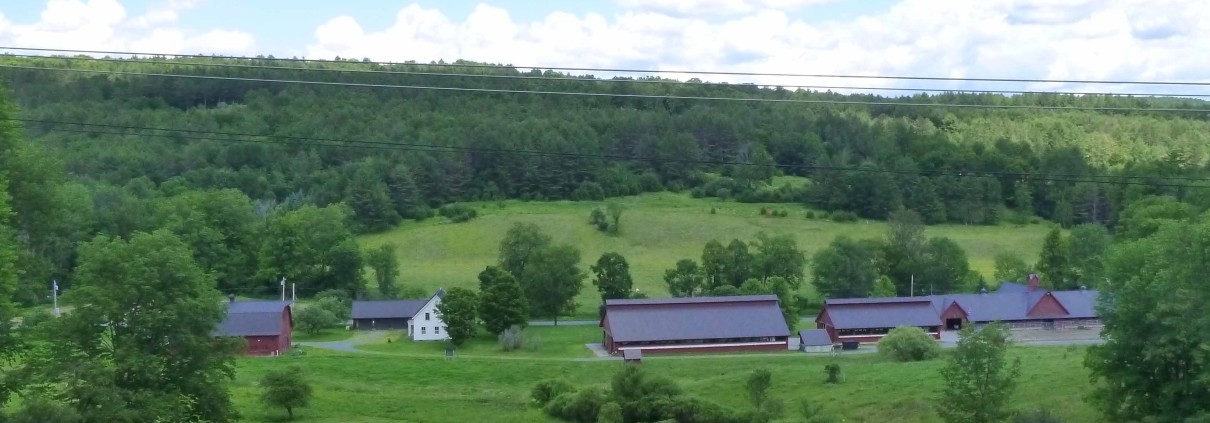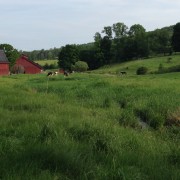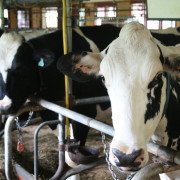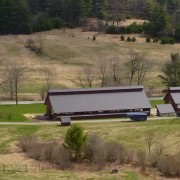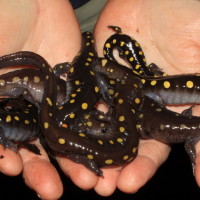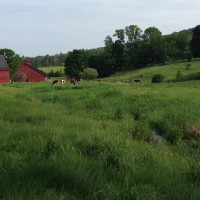UVLT Prepares to Purchase Norwich Farm
UVLT is preparing to purchase about 6 acres of developed land on Turnpike Road in Norwich. The land is adjacent to UVLT’s Brookmead Conservation Area, 352 acres of forest and farmland with trails.
The 6 acres is currently owned by Vermont Technical College (VTC). A number of barns and related structures are situated there along with a farmhouse and the mobile home. Most of the buildings were constructed by Andrew Sigler in the 1990s. He called his farm, which originally included the 352 acres, Norwich Farms. The 6-acres contains the farm building complex. It is not farmland.
UVLT came to own the 352 acres of forest and farmland through a collaboration with VTC. In 2015 President VTC Dan Smith believed that the Norwich Farms building complex would be a good location for VTC’s dairy education program and Andrew Sigler agreed to give the school the entire 358 acres. But VTC’s Board was not able to accept the gift because they did not have funds in hand to cover start-up costs. UVLT pledged $300,000 to purchase all but the 6 developed acres. This provided immediate, ready cash that VTC could use without interest costs or collateral. UVLT and VTC created an option contract that allows UVLT “to purchase the buildings in order to protect/sustain charitable community farm and educational use of the property in the event that VTC’s needs were to change at some point in the future.†The option price was set at $50,000 — so as not to create an incentive for the school to abandon its program.
The 352 acres is UVLT’s property already. It is not subject to the option.
The option contract between UVLT and VTC was recorded simultaneously with UVLT’s purchase of the land from VTC in July 2015. 15 months later VTC entered into an unrecorded long-term lease agreement with Chris and Laura Gray, who planned to operate Norwich Farm Creamery. UVLT had no role in developing the Gray’s lease and is not a party to it. We first received a copy of the lease last fall. UVLT’s legal interest in the property would have been readily findable in a title search.
In September 2017, VTC’s President and their Dean of Administration met with Chris and Laura Gray and a UVLT’s President and Vice Chair of the Board to inform us that VTC would be discontinuing its programs and wished to trigger the option contract. At that time, the Grays indicated that their business would not be able to sustain any increase in their lease rates. VTC indicated that the school had been funding site expenses in light of services the Grays provided to the school in connection with its educational program at the farm.
During the September meeting, UVLT indicated that it would not require those services and was not in a position to take on the costs that VTC had been covering. UVLT told the Grays that their occupancy arrangements would need to be re-evaluated if UVLT exercised the option. UVLT would be considering other proposals for uses and programs that cover site costs and are congruent with UVLT’s charitable mission and strategic objectives.
UVLT is committed to explore whether the buildings should be put to some good purpose, consistent with our original conservation goals for the adjacent conserved land, which would serve to advance important social and environmental needs in the Upper Valley, to demonstrate that land conservation is relevant and can work for the whole community. We are inspired by the examples of other conservancies across the country that have been really innovative in how they’ve used their sites: places where food (including meat and milk) is produced for hungry people, places where vets and folks who have experienced trauma can work with animals, places that give job training to people coming out of incarceration, places for urban children to experience nature. Each successful program is driven by the unique strengths of the conservancy behind it, and the constellation of partners who are drawn together — and what is critical is to make sure that the financial underpinnings of the program are strong from the start. So UVLT decided to solicit proposals from interested potential partners — including both for-profit and non-profit organizations — to get a dialogue started, but we would take 6 months to a year, if necessary, to get this right.
In the five months since, UVLT has continued to identify prospective tenants and alternative tenancy arrangements to develop a sound economic plan. We are seeking to create a plan that meets charitable and mission objectives and can support these annual costs without requiring subsidy from UVLT’s operating budget. We hired a business consultant who has strong experience in farm viability and regularly works with lenders and funders of farm projects. We are in steady dialogue with agricultural program leaders in Vermont and New Hampshire, with successful farmers and those who counsel and matchmake for incoming farmers, and with the managers of community farms and conservancies across the country that host innovative programs on properties they own.
VTC supplied us with information about their costs associated with ownership and maintenance of the property, which were over $100,000 per year. Obviously, UVLT’s site costs depend, in part, on what types of programs and uses are occurring on the property. We have estimated, based on the financial information provided by VTC, that UVLT’s costs will likely be around $60-80,000 annually, not counting utilities, to maintain, insure, and pay taxes on the $1 million of buildings and residences.
As a non-profit charity, UVLT also is responsible to ensure that charitable dollars are used only for charitable purposes. This means that lease rates, payments for services and other quid pro quo arrangements must be carefully scrutinized for fairness in the marketplace. This is especially complicated when a site owned by a charity is used by both for-profit and non-profit activities. In particular, UVLT will need to establish a fair market rent rate for the residential portion of the property.
VTC has clarified that the milk processing equipment that they own and had installed in Norwich will be removed and taken to Randolph prior to closing. This equipment will not be available for use in Norwich, nor are VTC classes of any type currently planned in Norwich.
During the option period, UVLT has been constrained in its ability to comment on these matters out of respect for the confidential nature of the Gray’s business planning, respect for the confidentiality of other farmers and entities who are potential tenants for some or all of the 6-acre site, and the landlord tenant relationship between VTC and the Grays; and VTC’s request that our direct contacts with the Grays should avoid interfering with VTC’s contractual arrangements with the Grays.
As UVLT and VTC move forward to close on the transfer of the property, UVLT looks forward to greater dialogue with Upper Valley residents about the future of the buildings at the Norwich Farm site and the opportunities to design sustainable programs and activities for the well being of the whole community. If you have questions or comments regarding the Norwich Farm property please contact us at norwichfarm@uvlt.org

